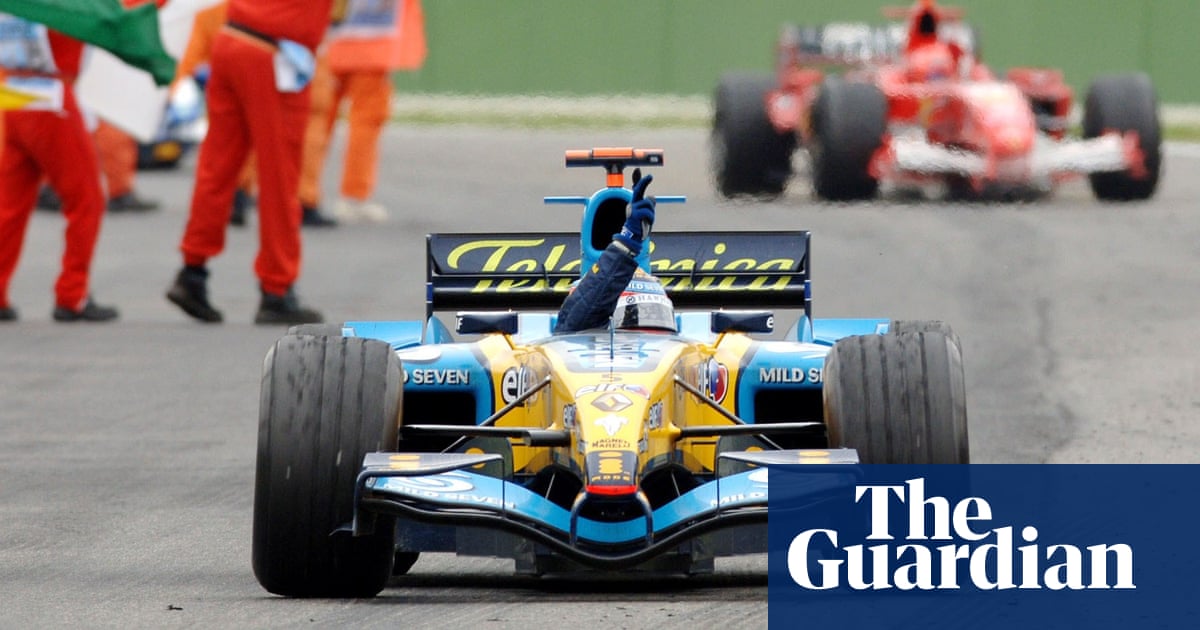The Emilia Romagna Grand Prix is taking place against a backdrop of severe doubts over Imola’sFormula Onefuture. The deaths of Roland Ratzenberger and Ayrton Senna at the 1994 San Marino Grand Prix remain etched on F1’s psyche but the demanding Autodromo Enzo e Dino Ferrari has been the scene of some of the sport’s most-compelling races. Here are three of the best:
Perhaps the finest of them all was Michael Schumacher’s tangle with the young pretender Fernando Alonso in 2005 as they went nose to rear wing in the closing laps, the Ferrari clearly the quicker car after a late fuel stop, but the Spaniard holding the world champion at bay.
Alonso, then 23, beat the imperious German to the flag by a fifth of a second with a study in defensive driving, his third victory in a row and the fourth win in four races for his Renault team.
Yet Schumacher’s masterful surge from 13th on the grid remains one of Formula One’s legendary drives. As Richard Williams reported in the Guardian: “On one lap he feinted to pass on the outside at the long Tosa hairpin, and on the next he probed for the inside. Going down the hill into Acque Minerali he attempted to push his car’s red nose alongside the Renault’s cockpit, and time and again he tried to get a run on Alonso at the Variante Alta, a chicane approached at 190mph. On each occasion Alonso, showing astonishing coolness, would hold a line that made it too risky for theFerrarito go for the pass.”
The grand prix’s gripping final 20 minutes enthralled the red-flag-wavingtifosi, but it was to mark the passing of an era of Ferrari dominance as Schumacher would secure only one grand prix victory that season – the US GP at Indianapolis Speedway – as Alonso claimed his first driver’s crown.
Alonso’s feat drew comparisons with Gilles Villeneuve’s win at Jarama, north of Madrid, in 1981 and Senna holding off a marauding Nigel Mansell at Monaco in 1992.
Remembered as the race won by a driver who never led a lap, and that had three different leaders in the last five laps without any of them winning.
In an era of thirsty turbo-charged engines, Imola was a punishing circuit for the wasteful. As Senna pointed out before the race: “Pole isn’t so important here at Imola than at some other tracks. It will be a long, hard race; hard on brakes and fuel consumption.”
Those words would come back to haunt him as, leading in a Lotus, Senna pulled up four laps from the chequered flag with his fuel tank dry. Then Stefan Johansson – in only his second race for Ferrari after they sacked René Arnoux – took over but he too dropped out a lap later cursing his bad luck after an electrical fault showed an incorrect fuel reading.
That left Alain Prost in a McLaren trying to coax every drop of fuel out of his car, but he crossed the finishing line 2kg underweight and the Frenchman’s hard-earned win was scrubbed by the stewards.
Next to cross the line was Senna’s Lotus teammate Elio de Angelis, and he was handed an unlikely victory after much wrangling. It was to be the popular Italian’s last. He was killed while testing a Brabham at Paul Ricard the following year.
Sign up toThe Recap
The best of our sports journalism from the past seven days and a heads-up on the weekend’s action
after newsletter promotion
Adding to the Imola farce, Thierry Boutsen ran out of fuel as he reached the start-finish straight on his final lap. To cross the line, he got out and pushed his Arrows to secure second place on the podium. As Williams’ laconic Nigel Mansell grumbled: “It wasn’t really racing.”
A downpour before the start left a saturated but drying Imola fraught with peril for the incautious. Max Verstappen read the conditions correctly and pipped the pole-sittingLewis Hamiltonto the first corner, surging from third on the grid and holding the inside line while Hamilton was forced wide and struck the kerbs, damaging his front wing.
Rather than losing ground, however, the Mercedes driver closed on his Red Bull rival as the track began to dry. Hamilton’s task was made all the harder when, in trying to lap George Russell, he was pushed wide again, his slicks crashing into the gravel.
Striking the barriers cost him a lap and apparently the race too. Yet at midway a huge shunt involving Valtteri Bottas and Russell led to a red flag and allowed Hamilton to rejoin in ninth place and work his way through the pack, finishing second behind Verstappen, who crossed the line 20 seconds in front of his Mercedes rival.
“The recovery drive was really brilliant,” the Mercedes principal, Toto Wolff, purred of Hamilton’s race. “It is a 10 out of 10.”
